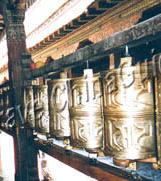 Places
Places
 Tibet
Tibet
 Buddhism
Buddhism
Don's Home
 Places
Places
 Tibet
Tibet
 Buddhism
Buddhism
| Contact |
 Under Construction. Under Construction.
Tibetan Buddhism SitesDharma HavenPrayer Wheels Prayer wheels, called Chokhor in Tibetan, are very common religious objects in Tibet. They are sometimes referred to as Mani wheels. Prayer wheels, called Chokhor in Tibetan, are very common religious objects in Tibet. They are sometimes referred to as Mani wheels.They are devices for spreading spiritual blessings and well being. Rolls of thin paper, imprinted with many, many copies of the mantra (prayer) Om Mani Padme Hum, printed in an ancient Indian script or in Tibetan script, are wound around an axle in a protective container, and spun around and around. Typically, larger decorative versions of the syllables of the mantra are also carved on the outside cover of the wheel. It is common for bucket-sized prayer wheels to be lined up on wooden racks along walking paths circling monasteries and other sacred sites, for the benefit of visiting pilgrims. Larger water, fire, and wind prayer wheels are built so that they are empowered by the flowing water, the flaming light, and the blowing wind which drive them, and can later pass their positive karma to all who touch them. See Prayer Wheel at Travel China Guide | |
Mani Mantra (Prayer)" Om Mani Padme Hum"Click to play: 
Tibetan Buddhists believe that saying the mantra (prayer) invites the blessings of Chenrezig, the embodiment of compassion. Om Mani Padme Hum can not really be translated into a simple phrase or even a few sentences. Gen Rinpoche, in his commentary on the Meaning of it said: "The mantra Om Mani Pädme Hum is easy to say yet
quite powerful,
because it contains the essence of the entire teaching.
When you say the first syllable So in this way recitation of the mantra helps achieve perfection in the six practices from generosity to wisdom. The path of these six perfections is the path walked by all the Buddhas of the three times. What could then be more meaningful than to say the mantra and accomplish the six perfections?" See The meaning of Om Mani Padme Hum for a much more complete explanation.
Six PerfectionsTo dream of reaching a destination is not enough you must pack your bags and set out on the journey. Bodhisattvas who are intent on enlightenment for the sake of all living beings make this a reality by adopting a certain way of life. All the advice the Buddha gave on this way of life and on the multifarious activities in which Bodhisattvas engage can be subsumed in the six perfections of giving, ethical discipline, patience, enthusiastic effort, concentration and wisdom. They comprise every practice needed to fully ripen oneself and others.Return to Religion or Tibet |